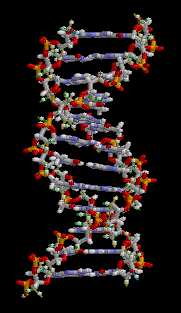That was a recent headline on a feature article from ScienceNews online. And without missing a beat, the primetime networks carried the story on the evening news. Please forgive me for being a tad skeptical concerning this announcement. I have lived long enough to see a plethora of allegedly astounding discoveries in support the Theory of Evolution find their way onto the junk heap of phony exaggerations. This news story was prompted by the discovery of NASA-funded researchers who say these meteorites that were likely (I guess that means they are not positive of their extraterrestrial origin) created in space.
They claim the research gives support to the theory that a “kit” of ready-made parts created in space and delivered to Earth by meteorite and comet impacts assisted the origin of life (NASA, 2011). As I read further, I learned the actual discovery did not include the actual biochemical components of DNA, but only minute traces of two of the four so-called building blocks of life.
 Deoxyribonucleic acid (DNA) is a long macromolecule that contains nitrogen as well as carbon, hydrogen, and oxygen. It is composed of basic units called nucleotides. These nucleotides contain the genetic instructions used in the development and functioning of all known living organisms (with the exception of RNA viruses). In living organisms, the DNA is found in the structure of a double helix. The backbone of the DNA chain is formed by sugar and phosphate groups of each nucleotide (Miller & Levine, 2004). The structure of the DNA molecule is described as a double helix that looks like a twisted ladder.
Deoxyribonucleic acid (DNA) is a long macromolecule that contains nitrogen as well as carbon, hydrogen, and oxygen. It is composed of basic units called nucleotides. These nucleotides contain the genetic instructions used in the development and functioning of all known living organisms (with the exception of RNA viruses). In living organisms, the DNA is found in the structure of a double helix. The backbone of the DNA chain is formed by sugar and phosphate groups of each nucleotide (Miller & Levine, 2004). The structure of the DNA molecule is described as a double helix that looks like a twisted ladder.
The steps in this ladder are what is commonly referred to as “the building blocks of life.” They consist of hydrogen bonds that form to connect the base pairs – adenine and thymine, and guanine and cytosine (Miller & Levine, 2004).
The structure of functional DNA, even in microorganisms, is so complex that even dedicated evolutionary scientists have serious doubts about the ability of the components of DNA to spontaneously form in nature via natural processes. Fred Hoyle (1915–2001), the late Professor of Astronomy at Cambridge University, wrote:
|
The chance that higher life forms might have emerged in this way is comparable with the chance that ‘a tornado sweeping through a junk yard might assemble a Boeing 747 from the materials therein.’ |
For those given to mathematical illustrations, Hoyle (1981) offers this:
|
At all events, anyone with even a nodding acquaintance with the Rubik cube will concede the near-impossibility of a solution being obtained by a blind person moving the cube faces at random. Now imagine 1050 blind persons each with a scrambled Rubik cube, and try to conceive of the chance of them all simultaneously arriving at the solved form. You then have the chance of arriving by random shuffling of just one of the many biopolymers on which life depends. The notion that not only the biopolymers but also the operating programme of a living cell could be arrived at by chance in a primordial organic soup here on the Earth is evidently nonsense of a high order. |
Hoyle and Wickramasinghe (1990), scientists not given to hyperbole, wrote:
|
The random chance is not a million to one against, but p to 1 against, with p minimally an enormous superastronomical number equal to 1040,000(1 followed by 40,000 zeros).The odds we have thus computed are only for the enzymes, and of course, correct arrangements with many other important macromolecules histone-4 and cytochrome-c are two such examples, each with exceedingly small probability of being obtained by chance. If all these other relevant molecules for life are also taken account of in our calculation, the situation for conventional biology becomes doubly worse. The odds of one in 1040,000 against are horrendous enough, but that would have to be increased to a major degree. Such a number exceeds the total number of fundamental particles through the observed Universe by very, very many orders of magnitude. So great are the odds against life being produced in a purely mechanistic way that the difficulties for an Earthbound, mechanistic biology are in our view intrinsically insuperable. We would appreciate your donation.
Such criticisms of this conclusion as have been voiced are, in the main, of a superficial polemical kind. By prevailing cultural standards, it is usually thought that this type of conclusion is so outrageous and unacceptable that it has to be fought and condemned at all costs. Facts themselves cease to be important, and it is considered permissible to pile unlikely hypotheses, one upon another. If there remains even the slightest chance of maintaining the status quo within some type of quasi-logical framework the situation is that anything goes. The hypotheses that come to be invoked take on an extremely complex character, which appear to remain invisible to the protagonists of conventional theory. |
So, when these NASA scientists announced their discovery, I was not impressed. The presence of infinitesimally small “traces” of adenine and guanine in these meteorites may be interesting, however, we should keep in mind that functional DNA is a relatively long macromolecule that is supercoiled. A typical DNA strand in our cells can be 50 – 250 million base-pairs long. The separation between the base-pairs (or the rungs of the ladder) is ~ 3.4 Angstroms. Therefore, the linear dimensions of our DNA are (250×106 bases) x (3.4×10-8 cm/base) = 8.5 cm. If we add up all the DNA in one of our cells, it can be about a meter long! The width of a double helix is only 2 nm. DNA molecules are therefore very long molecular threads (University of Illinois at Chicago, 2011).
The Devil is always in the details
As is true with many of these sensational announcements, the devil is in the details. While making a case that these nucleobase analogs of adenine and guanine were not of earthly origin, e.g. not the result of terrestrial contamination, the researchers tested the levels of adenine and quainine in the area surrounding the meteorites. While the levels tested seemed to point to an extraterrestrial source, I noticed just how small these nucleobase analogs really were. The team was measuring these traces in parts per billion (ppb), while noting that they existed in the ice surrounding their meteorites in a much lower level, e.g. parts per trillion (ppt). When we actually look at the size of these nucleobase analogs of adenine and guanine (or any substance found in the ppb level), we see just how tiny these trace substances really are. One part per billion (ppb) denotes one part per 1,000,000,000 parts or a value of 1 × 109. This is equivalent to one drop of water diluted into 250 chemical drums (50 m3), or about three seconds out of a century (Wikipedia, 2011).
Aside from the problem of testing for minute substances, we have the long list of discoveries that later turned out to be nothing more than “much ado about not much.” Does anyone remember the extraterrestrial bacteria meteorite labeled ALH 84001? This was the 1996 discovery that looked very much like a segmented worm, only it was much, much smaller, close to the size of a microorganism. The notorious ALH 84001 meteorite sample made such a splash on the national scene, that our then president, Bill Clinton, took to the airwaves to address the nation (O’Neill, 2011).
Enter NASA astrobiologist, Dr Richard Hoover, who has been on a quest to find fossil evidence of bacteria inside meteorites the world over. He has been following up on earlier discoveries that have become important due to the fact that they seem to lend credence to the hypothesis of Directed Panspermia. The notion made popular by the co-discoverer of the DNA molecule, the late Professor Francis Crick, who along with Leslie Orgel, first proposed the theory of Directed Panspermia (Crick & Orgel, 1973). Hoover will continue to build his case for extraterrestrial life from inside of earth bound meteorites. I wonder how hot the inside of a meteorite gets when it hurls towards the earth. That is, if they are not completely incinerated (as most are) as they burn up in the earth’s atmosphere. I think it might get fairly hot, perhaps hotter than any thermopile could possible endure. But those questions won’t dampen the faith of these astrobiologists. Don’t laugh. There are well known institutions of higher learning, that now offer graduate certificates in astrobiology or dual Ph.D. degrees combing classic astronomy and astrophysics (among other science disciplines) with this novel, sci-fi like discipline (NASA Astrobiology Institute, 2011).
Just add water and mix…for a couple of billion years
In time, the ALH 84001evidence of extraterrestrial life was debunked, but that did not discourage NASA from continuing their own quest to find life apart from that which exists on planet Earth. That is why I am somewhat skeptical concerning NASA’s announcements. We should also remember that NASA is facing huge budget cuts. The space shuttle program is over and even more budgetary cuts are expected. NASA is headed for some harsh economic times and big announcements like this is a way of staying in the public eye. This is a possible strategy for getting Congress and the President to protect them from deeper fiscal in the future.
I know that in every space probe NASA had designed, they have devoted a major portion of their technology to finding water. If Directed Panspermia is true, and you better believe that most of NASA’s scientists believe that it is, then they must locate a good source of extraterrestrial water. Water is an essential ingredient in all carbon-based life forms. That is something that NASA understands all too well. It is the Theory of Evolution’s equation for the origin of life on planet Earth, e.g. “Just add water and mix…for a couple of billion years.”
Can we expect them to continue to hype look-a-like extraterrestrial microorganisms as evidence that life on earth began in outer space? I would say yes. Will they continue to make incredible statements concerning the extraterrestrial origin of life? What do you think this latest NASA announcement was about? Can we expect the next Mars probe to land in the polar regions of the red planet? Definitely. Why do you think all of this research is being done in the arctic regions of our own planet? That continues to the focus of NASA, and that has been a primary goal of the organization since 1958 when Congress established the agency. Can we expect some clever NASA scientist to claim that we are the real aliens? Just take one more look at the headline chosen for NASA’s big announcement, “DNA Building Blocks Can Be Made in Space, NASA Evidence Suggests.” I rest my case.
Source:Creation Studies Institute




